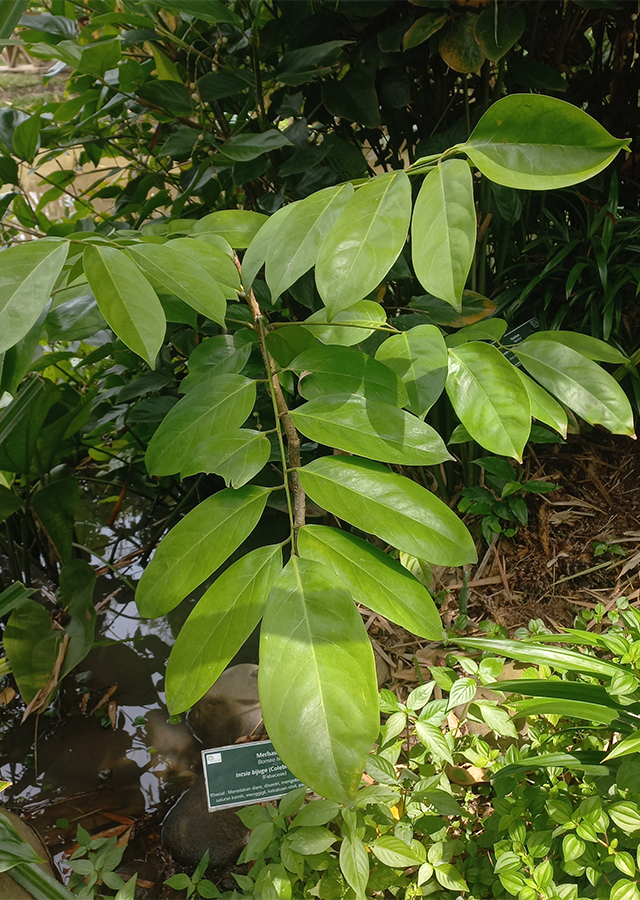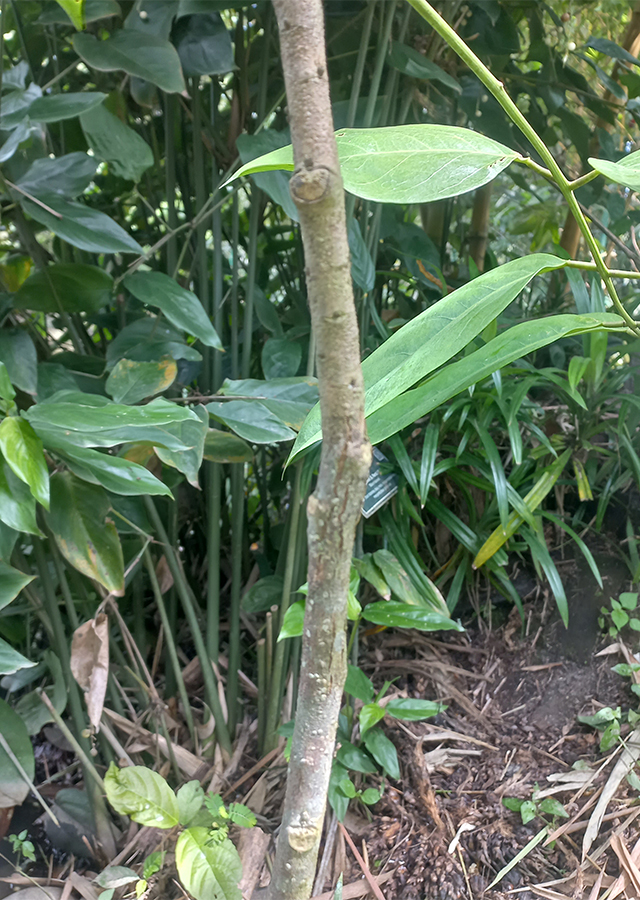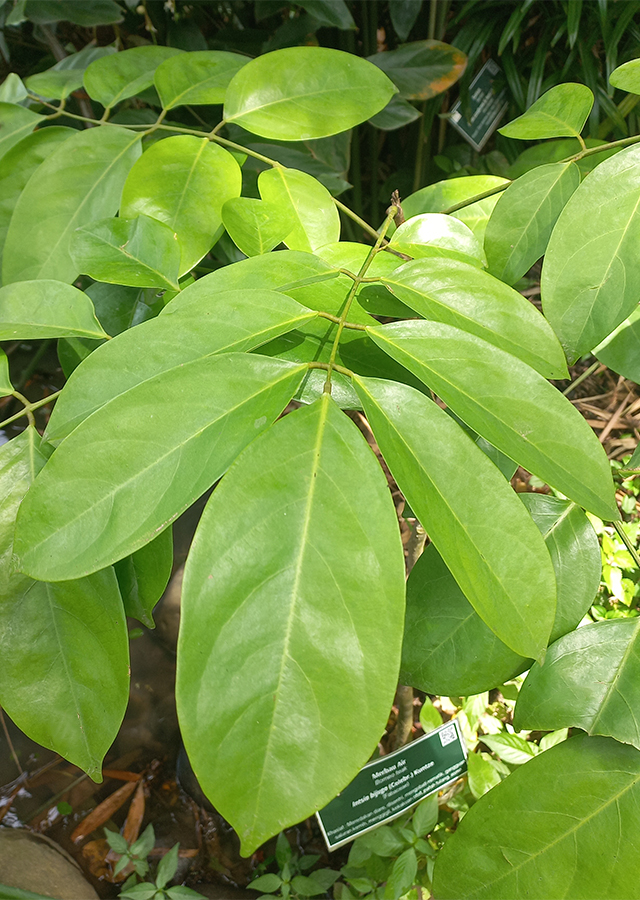Borneo Teak
Intsia bijuga (Colebr.) Kuntze
Fabaceae
Location in our garden
Aquatic



Synonym
Afzelia bijuga (Colebr.) A.Gray
Macrolobium bijugum Colebr.
Outea bijuga (Colebr.) DC.
Habitus
Trees. Perennial medium-sized, slow growing tree reaching a height of 20 to 50 m
Part Used
Bark
Growing Requirements
Full Sunshine
Habitat
Forest
Coastal
Roadside
Terrestrial
Overview
Intsia bijuga is very widespread in coastal regions of islands in the Indian and Pacific Oceans, including eastern Madagascar and the Seychelles. It has been planted near the sea-shore in Tanzania and in Mauritius. The wood of Intsia bijuga, known as ‘hintsy’, is highly prized for heavy carpentry, construction including naval construction, flooring, joinery, doors, furniture, railway sleepers, vats, shingles and decorative purposes. It is considered one of the best woods available in the eastern lowlands, being beautiful and strong. Traditionally, it has been used for coffins and canoes. In tropical Asia, the wood is known as ‘merbau’ together with the wood of Intsia palembanica Miq. Merbau is important on the international timber market. It is a very good general-purpose timber because of its favourable physical and mechanical properties, combined with a high natural durability and an attractive appearance.
Vernacular Names
Faux teck (French), Merbau ipil (Merbau ipil), Kwila (Papua New Guinea), Lumpho-thale (Thai), Go-nuoc (Vietnamese).
Agroecology
Habitat Intsia bijuga is generally found growing in undisturbed moist forests in the eastern coastal zone, can also be found in coastal areas, often in the zone behind mangrove forests, but is also found inland up to 600 m above sea level. Usually grows in areas with an average annual rainfall of 2000 – 3000(–3500) mm, with up to 3 dry months, and an average annual temperature of around 24 - 27 °C, on well-drained sandy soil media with a pH of 4 ,7–5,3. Intsia bijuga also has some resistance to salt spray and saline soil and wind. However, I. bijuga cannot tolerate longer periods of drought.
Morphology
- Trunks - bole often low-branching but sometimes branchless for up to 18 m, up to 80(–120) cm in diameter, often buttressed in older trees; bark surface smooth, pale grey to pale brown, inner bark thick, fibrous, pale red to pale yellowish brown; crown rounded to umbrella-shaped, dense; twigs glabrous.
- Leaves - alternate, paripinnately compound with (1–)2–3 pairs of leaflets; stipules fused at base, forming a persistent scale; petiole thick, 1–2 cm long, rachis up to 8 cm long; leaflets asymmetrically ovate or elliptical to nearly round, 4–16 cm × 3–11 cm, obtuse to rounded, often slightly notched at apex, margins entire, leathery, glabrous, pinnately veined with 12–20 pairs of lateral veins.
- Flowers - inflorescence a terminal panicle up to 10 cm long, short-hairy. Flowers bisexual, zygomorphic, whitish; pedicel 3–5 mm long, with 2 deciduous bracteoles; hypanthium elongate, 6–8 mm long; sepals 4, unequal, ovate, 6–16 mm × 4–6 mm, short-hairy; petal 1, 1–3 cm long, with claw at base and crisped lamina broader than long, white tinged yellow or pink; stamens 3, c. 4 cm long, hairy, purple-red, staminodes 4–7, c. 1 cm long; ovary superior, compressed spindle-shaped, 2–3 mm long, hairy, 1-celled, with c. 2 mm long stipe, style up to 4 cm long.
- Fruits - an oblong, flattened pod 7–28 cm × 3–7 cm, glabrous, pale brown, with slightly raised veins, tardily dehiscent with 2 leathery to woody valves, up to 6-seeded.
- Seeds - discoid to oblong, 1.5–3.5 cm × 1–3 cm, dark brown, more or less covered with detachable rusty brown scurf. Seedling with epigeal germination.
Cultivation
- Propagated by seeds, cuttings and root suckers.
- Seedlings require high light intensity for optimal growth, and in the open they grow much faster than under closed canopy conditions. However, experiments in Indonesia showed that seedling growth in the shade or under a shady tree was faster than in full sun. Proper drainage and high humidity are essential for good growth. Seedlings can be transferred to the field when they are about 3 months old, at a spacing of 3 m × 4 m or 5 m × 5 m.
Chemical Constituents
Tannins, anthrones, flavonoids, glycosidic flavonoids, phenolic compounds, steroids, triterpenes, anthraquinones, coumarins, robinetin (the main polyphenol of heartwood) along with 3,5,4'-tri and 3,5,3',4'-tetrahydroxystilbenes, dihydromyricetin myricetin, and narigenin.
Traditional Medicinal Uses
- Bark used for diarrhea. Also used for urinary conditions.
- Fruit used as laxative.
- In Fiji, decoction of bark used for rheumatism, chills, diarrhea, muscle rigidity and rheumatoid arthritis; mixed with the extracts of other plants, used for broken bones.
- Juice of stems used for asthma.
- Mixed with other plant extracts, used for toothache and sore tongue. Also used for scabies and headaches.
- Bark infusion given to women after delivery.
- In the Solomon Islands, used to treat very dark urine caused by sorcery; also used for rheumatism, diarrhea and dysentery.
- In Samoa, bark used for treating enlarged lymph nodes.
- In Vanuatu, the inner bark of Intsia bijuga, squeezed in coconut water, is taken as a remedy for asthma.
- Inner bark are squeezed in salt water and the solution is ingested for diabetes.
Part Used
Reference Sources
- Royal Botanic Gardens. Plants of the World Online: Intsia bijuga (Colebr.) Kuntze. https://powo.science.kew.org/taxon/urn:lsid:ipni.org:names:500954-1. 25-09-22.
- Stuartxchange. 2018. Philippine Medicinal Plants: Ipil. http://www.stuartxchange.org/Ipil. 25-09-22.
- PROTA4U. Intsia bijuga (Colebr.) Kuntze. https://prota4u.org/database/protav8.asp?g=pe&p=Intsia+bijuga+(Colebr.)+Kuntze. 25-09-22.
- Flora Fauna Web. 2022. Intsia bijuga (Colebr.) Kuntze. https://www.nparks.gov.sg/florafaunaweb/flora/2/9/2971. 25-09-22.
